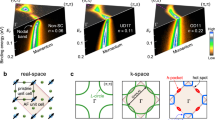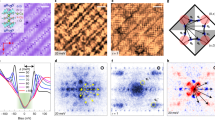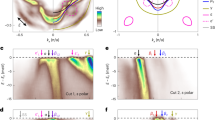Abstract
The iron arsenic high-temperature superconductors1,2 exhibit particularly rich phase diagrams. In the AE(Fe1−xTx)2As2 family (known as ‘122’, with AE being Ca, Sr or Ba and T being a transition metal), the simultaneous structural/magnetic phase transition that occurs at elevated temperature in the undoped material splits and is suppressed by carrier doping3,4. A superconducting region appears as likely in the orthorhombic/antiferromagnetic (AFM) state as in the tetragonal/paramagnetic state3,5,6. An important question then is what determines the critical doping at which superconductivity emerges, as the AFM order is fully suppressed only close to optimal doping. Here we report evidence from angle-resolved photoemission spectroscopy that marked changes in the Fermi surface coincide with the onset of superconductivity in electron-doped Ba(Fe1−xCox)2As2. The presence of the AFM order leads to a reconstruction of the electronic structure, most significantly the appearance of the petal-like hole pockets at the Fermi level. These hole pockets vanish—that is, undergo a Lifshitz transition7—as the cobalt concentration is increased sufficiently to support superconductivity. Superconductivity and magnetism are competing states in this system: when petal-like hole pockets are present, superconductivity is fully suppressed, whereas in their absence the two states can coexist.
This is a preview of subscription content, access via your institution
Access options
Subscribe to this journal
Receive 12 print issues and online access
$259.00 per year
only $21.58 per issue
Buy this article
- Purchase on SpringerLink
- Instant access to full article PDF
Prices may be subject to local taxes which are calculated during checkout



Similar content being viewed by others
References
Kamihara, Y., Watanabe, T., Hirano, M. & Hosono, H. Iron-based layered superconductor La[O1−xFx]FeAs (x=0.05–0.12) with Tc=26 K. J. Am. Chem. Soc. 130, 3296–3297 (2008).
Rotter, M., Tegel, M. & Johrendt, D. Superconductivity at 38 K in the iron arsenide (Ba1−xKx)Fe2As2 . Phys. Rev. Lett. 101, 107006 (2008).
Ni, N. et al. Effects of Co substitution on thermodynamic and transport properties and anisotropic Hc2 in Ba(Fe1−xCox)2As2 single crystals. Phys. Rev. B 78, 214515 (2008).
Canfield, P. C., Bud’ko, S. L., Ni, N., Yan, J. Q. & Kracher, A. Decoupling of the superconducting and magnetic (structural) phase transitions in electron-doped BaFe2As2 . Phys. Rev. B 80, 060501 (2009).
Pratt, D. K. et al. Coexistence of competing antiferromagnetic and superconducting phases in the underdoped Ba(Fe0.953Co0.047)2As2 compound using X-ray and neutron scattering techniques. Phys. Rev. Lett. 103, 087001 (2009).
Lester, C. et al. Neutron scattering study of the interplay between structure and magnetism in Ba(Fe1−xCox)2As2 . Phys. Rev. B 79, 144523 (2009).
Lifshitz, I. M. Anomalies of electron characteristics of a metal in the high pressure region. Sov. Phys. JETP 11, 1130–1135 (1960).
Liu, G. et al. Band-structure reorganization across the magnetic transition in BaFe2As2 seen via high-resolution angle-resolved photoemission. Phys. Rev. B 80, 134519 (2009).
Yang, L. X. et al. Electronic structure and unusual exchange splitting in the spin-density-wave state of the BaFe2As2 parent compound of iron-based superconductors. Phys. Rev. Lett. 102, 107002 (2009).
Zhang, Y. et al. Unusual doping dependence of the electronic structure and coexistence of spin-density-wave and superconductor phases in single crystalline Sr1−xKxFe2As2 . Phys. Rev. Lett. 102, 127003 (2009).
Hsieh, D. et al. Experimental determination of the microscopic origin of magnetism in parent iron pnictides. Preprint at http://arxiv.org/abs/0812.2289 (2008).
Kondo, T. et al. Unexpected Fermi-surface nesting in the pnictide parent compounds BaFe2As2 and CaFe2As2 revealed by angle-resolved photoemission spectroscopy. Phys. Rev. B 81, 060507(R) (2010).
Liu, C. et al. Three- to two-dimensional transition of the electronic structure in CaFe2As2: A parent compound for an iron arsenic high-temperature superconductor. Phys. Rev. Lett. 102, 167004 (2009).
Yi, M. et al. Unconventional electronic reconstruction in undoped (Ba,Sr)Fe2As2 across the spin density wave transition. Phys. Rev. B 80, 174510 (2009).
Zabolotnyy, V. B. et al. (π,π) electronic order in iron arsenide superconductors. Nature 457, 569–572 (2009).
Zhang, J., Sknepnek, R., Fernandes, R. M. & Schmalian, J. Orbital coupling and superconductivity in the iron pnictides. Phys. Rev. B 79, 220502(R) (2009).
Christianson, A. D. et al. Static and dynamic magnetism in underdoped superconductor BaFe1.92Co0.08As2 . Phys. Rev. Lett. 103, 087002 (2009).
Terashima, K. et al. Fermi surface nesting induced strong pairing in iron-based superconductors. Proc. Natl Acad. Sci. USA 106, 7330–7333 (2009).
Mun, E. D., Bud’ko, S. L., Ni, N. & Canfield, P. C. Thermoelectric power and Hall coefficient measurements on Ba(Fe1−xTx)2As2 (T=Co and Cu). Phys. Rev. B 80, 054517 (2009).
Fang, L. et al. Roles of multiband effects and electron–hole asymmetry in the superconductivity and normal-state properties of Ba(Fe1−xCox)2As2 . Phys. Rev. B 80, 140508(R) (2009).
Rullier-Albenque, F. et al. Hall effect and resistivity study of the magnetic transition, carrier content, and Fermi-liquid behavior in Ba(Fe1−xCox)2As2 . Phys. Rev. Lett. 103, 057001 (2009).
Ni, N. et al. Phase diagrams of Ba(Fe1−xMx)2As2 single crystals (M=Rh and Pd). Phys. Rev. B 80, 024511 (2009).
Butch, N. P. et al. Effective carrier type and field-dependence of the reduced-Tc superconducting state in SrFe2−xNixAs2 . Phys. Rev. B 81, 024518 (2010).
Evtushinsky, D. V. et al. Momentum dependence of the superconducting gap in Ba1−xKxFe2As2 . Phys. Rev. B 79, 054517 (2009).
Park, J. T. et al. Electronic phase separation in the slightly underdoped iron pnictide superconductor Ba1−xKxFe2As2 . Phys. Rev. Lett. 102, 117006 (2009).
Fukazawa, H. et al. 75As NMR study of hole-doped superconductor Ba1−xKxFe2As2(Tc≃38 K). J. Phys. Soc. Jpn 78, 033704 (2009).
Fernandes, R. M. et al. Unconventional pairing in the iron arsenide superconductors. Phys. Rev. B 81, 140501(R) (2010).
Schrieffer, J. R. Wards identity and the suppression of spin fluctuation superconductivity. J. Low Temp. Phys. 99, 397–402 (1995).
Parker, D., Vavilov, M. G., Chubukov, A. V. & Mazin, I. I. Coexistence of superconductivity and a spin density wave in pnictide superconductors: Gap symmetry and nodal lines. Phys. Rev. B 80, 100508(R) (2009).
Acknowledgements
We acknowledge Y. S. Kim for his excellent instrumental support at ALS. Ames Laboratory is supported by the Department of Energy—Basic Energy Sciences under Contract No. DE-AC02-07CH11358. ALS is operated by the US DOE under Contract No. DE-AC03-76SF00098.
Author information
Authors and Affiliations
Contributions
T.K., C.L. and A.K. devised the concept of the experiments; T.K., C.L., A.K., A.D.P., A.B. and E.R. carried out the ARPES measurements; C.L. analysed the ARPES data with support from T.K. and A.D.P.; R.M.F. and J.S. developed the theoretical model and carried out calculations. N.N., A.N.T., E.D.M., S.L.B. and P.C.C. provided the single crystals and carried out the transport measurements. C.L. prepared the manuscript with support from A.K., P.C.C. and J.S. Section I of the Supplementary Information was prepared by R.M.F. All authors made a substantial contribution.
Corresponding author
Ethics declarations
Competing interests
The authors declare no competing financial interests.
Supplementary information
Supplementary Information
Supplementary Information (PDF 661 kb)
Rights and permissions
About this article
Cite this article
Liu, C., Kondo, T., Fernandes, R. et al. Evidence for a Lifshitz transition in electron-doped iron arsenic superconductors at the onset of superconductivity. Nature Phys 6, 419–423 (2010). https://doi.org/10.1038/nphys1656
Received:
Accepted:
Published:
Issue date:
DOI: https://doi.org/10.1038/nphys1656
This article is cited by
-
Field-induced Lifshitz transition in the magnetic Weyl semimetal candidate PrAlSi
npj Quantum Materials (2023)
-
Quantum coherence tomography of light-controlled superconductivity
Nature Physics (2023)
-
Two distinct superconducting states controlled by orientations of local wrinkles in LiFeAs
Nature Communications (2021)
-
Visualizing band selective enhancement of quasiparticle lifetime in a metallic ferromagnet
Nature Communications (2021)
-
First-principles study of the transition metal-doped iron-based superconductor AFe2As2 (A = Ba, Sr)
Journal of Materials Science (2021)



